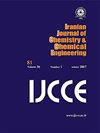Evaluation, Preparation and Characterization of Chitosan/ZnO Nanocomposite and Antibacterial activity against pathogenic microbial strains
IF 1
4区 工程技术
Q4 CHEMISTRY, MULTIDISCIPLINARY
Iranian Journal of Chemistry & Chemical Engineering-international English Edition
Pub Date : 2021-06-22
DOI:10.30492/IJCCE.2021.135154.4292
引用次数: 0
Abstract
Abstract: Objective (s): Background: Nanotechnology is used as a tool to develop advanced therapies and control the fight against infections. The aim of this study was to evaluate of the physicochemical properties such as morphological analysis of the chitosan nanocomposite on oxide composite through a simple method and to investigate the anti-bacteria properties of them.Materials and Methods: The study method in in this study was experimental and the chitosan-zinc oxide nanocomposite was chemically precipitated after preparation of the Chitosan/ZnO nanocomposite physicochemical properties and antibacterial activity against pathogenic microbial strains was investigated. The nanocomposite was evaluated using SEM, FTIR techniques, XRD X-ray diffraction and DLS particle size distribution. The antimicrobial effect of this nanocomposite was evaluated on the bacteria Staphylococcus aureus and Micrococcus luteus. In this study, the antimicrobial effect of Chitosan/ZnO nanocomposite ZnO nanoparticles loaded in chitosan was investigated by MIC method on microorganisms (Candida albicans, Microscotus luteus and Staphylococcus aureus).Results: The results showed that the concentration of zinc oxide nanoparticles affected the antimicrobial activity of chitosan nanocomposite. In this study, the antimicrobial behaviour of the Chitosan/ZnO nanocomposite zinc oxide was determined against pathogenic microbial strains of bacteria including Escherichia coli, Pseudomonas aeruginosa, Serratia marcescens, Micrococcus luteus, Bacillus subtilis, Staphylococcus aureus, and Klebsiella pneumoniaagainst E .Coli was investigated and the results show that zinc oxide has an antimicrobial effect against Escherichia coli and also the use of two types of dispersants (peg / pvp) on antimicrobial activity of zinc with MIC .(Minimum inhibitory concentration) approach. The ZnO nanoparticlesoxide has no effect and onlyin the Chitosan/ZnO nanocomposite increases the stability of the suspensions. Conclusion: Based on the results, the synthesized compounds have an antimicrobial effect and the antimicrobial effect has increased with increasing polymer (chitosan) concentration. The antimicrobial effect has been seen on gram-positive and gram-negative bacteria.壳聚糖/ZnO纳米复合材料的制备及抗菌活性研究
摘要:目的:背景:纳米技术被用作开发先进治疗方法和控制感染的工具。本研究的目的是通过简单的方法来评价壳聚糖纳米复合材料与氧化物复合材料的理化性质,如形态分析,并研究它们的抗菌性能。材料与方法:本研究采用实验方法,通过化学沉淀法制备壳聚糖/氧化锌纳米复合材料,考察壳聚糖/氧化锌纳米复合材料的理化性质和对病原菌的抑菌活性。利用扫描电镜(SEM)、红外光谱(FTIR)、x射线衍射仪(XRD)和DLS对纳米复合材料的粒径分布进行了表征。研究了该纳米复合材料对金黄色葡萄球菌和黄体微球菌的抑菌效果。本研究采用MIC法研究了壳聚糖/氧化锌纳米复合材料对白色念珠菌、黄体微scotus和金黄色葡萄球菌的抑菌效果。结果:氧化锌纳米颗粒的浓度对壳聚糖纳米复合材料的抑菌活性有影响。本研究测定了壳聚糖/氧化锌纳米复合材料对大肠杆菌、铜绿假单胞菌、粘质沙雷氏菌、黄体微球菌、枯草芽孢杆菌、金黄色葡萄球菌等病原菌的抗菌性能。结果表明,氧化锌对大肠杆菌具有一定的抑菌作用,并采用最小抑菌浓度法对两种分散剂(peg / pvp)的抑菌活性进行了研究。氧化锌纳米颗粒对壳聚糖/氧化锌纳米复合材料的稳定性没有影响,只有在壳聚糖/氧化锌纳米复合材料中才增加了悬浮液的稳定性。结论:合成的化合物具有一定的抗菌作用,且抗菌作用随聚合物(壳聚糖)浓度的增加而增强。对革兰氏阳性和革兰氏阴性细菌均有抗菌作用。
本文章由计算机程序翻译,如有差异,请以英文原文为准。
求助全文
约1分钟内获得全文
求助全文
来源期刊

Iranian Journal of Chemistry & Chemical Engineering-international English Edition
CHEMISTRY, MULTIDISCIPLINARY-ENGINEERING, CHEMICAL
CiteScore
2.80
自引率
22.20%
发文量
0
审稿时长
6-12 weeks
期刊介绍:
The aim of the Iranian Journal of Chemistry and Chemical Engineering is to foster the growth of educational, scientific and Industrial Research activities among chemists and chemical engineers and to provide a medium for mutual communication and relations between Iranian academia and the industry on the one hand, and the world the scientific community on the other.
 求助内容:
求助内容: 应助结果提醒方式:
应助结果提醒方式:


